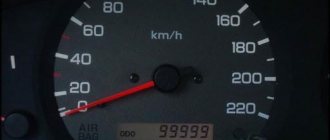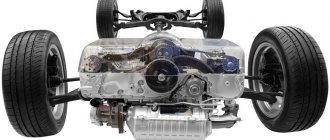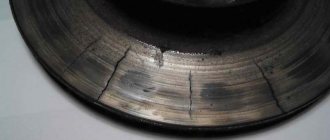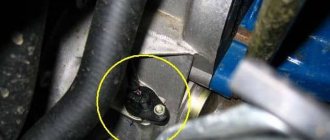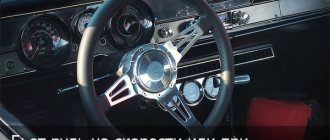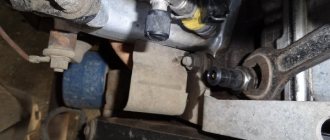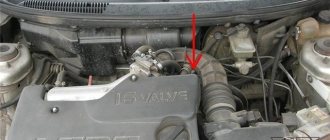Any driver is very alarmed by situations when vibration appears at a speed of 100-120 km/h on the steering wheel or along the body. And the point here is not only about discomfort, although it must be said that these symptoms are a rather unpleasant phenomenon. If measures are not taken to correct the problem in time, this may lead to a violation of the geometry of the body. This will not happen immediately, but slowly and gradually.
Distortions can provoke a violation of the aerodynamic characteristics, as well as deterioration of the vehicle's handling. In addition, due to vibration effects, cracks can form in the metal, which is not only dangerous in itself, but also requires expensive repairs.
And that's not the whole problem. If the car vibrates at a speed of 100-120 (VAZ 2110 is no exception), this leads to the loosening of various fasteners. This phenomenon can lead to serious consequences - accidents, as well as various malfunctions and damages, which will be very difficult to eliminate. It is worth adding that this kind of shaking is a signal of breakdowns that will yet occur in the near future.
Vibration at speeds of 100-120 km/h occurs for various reasons. These may be completely harmless problems. But sometimes there are serious cases that require global intervention in the technical structure of the car. Further in the article we will look at the typical reasons why vibration is transmitted to the steering wheel and car body at high speeds.
Balancing is out of balance
If there is vibration in the steering wheel at a speed of 100-120 km/h, the first thing you should do is inspect the wheels and tires. They're not perfect. The discs may be uneven or uneven in composition. Since the weight is different in different places of the tire or disk, during the rotation process the place where the mass is greater will pull the center of gravity towards itself. This is nothing more than the effect of centrifugal force. Accordingly, at high wheel speeds, this impact will necessarily be transmitted through the rack and rods to the steering wheel. In case of other damage for the same reason, vibration will also occur on the body.
What is the way out of this situation? The driver needs to balance the wheels. It's better to do this periodically. Balancing is also required when “re-shoeing”. What is this process? This is equalizing the weight of the wheel at each point. If violations are detected, the specialist sticks special weights on the disc.
It is impossible to operate a car for a long time on unbalanced wheels. This can cause severe wear in certain areas of the tire, which will increase vibration. Also, because of this, almost all components and suspension units of the car wear out excessively. The hub bearings are also subject to heavy loads.
Worn suspension
Heavily worn chassis components can cause vibration in the steering wheel. Suspension affects the vehicle's contact with the road. If there is play in the chassis, then this is the cause of the imbalance during rotation. But suspension play is only a “catalyst” for wheel vibration. It in itself cannot serve as the main reason for steering wheel vibration.
Speeds of 100-120 (VAZ - 2108 is no exception) can demonstrate it to you when the car has a faulty steering mechanism. It is necessary to eliminate these breakdowns first. It may be dangerous. However, problems should be diagnosed last, if all other components are in perfect order.
The wheel alignment is broken
Directly depending on the incorrectly set angle, vibration can only occur during acceleration or in a certain speed range. Incorrect wheel alignment can be detected very quickly - tires wear unevenly.
If only the outer or only the inner part is wiped, then this is the same situation. The problem can be corrected by adjusting the angles. Then the vibration in the body at a speed of 100-120 km/h will disappear.
But the camber/toe has been adjusted, but the problem has not gone away. The angle has been corrected, that's a fact. But the car owner decided not to change the tires, because they can still drive. But the tires “drive” the way they are used to. This means that you need to change the tires or drive at low speeds for a period of time, then the tread will wear out evenly and the problem will be solved.
Steering wheel vibration at speed 80 100 120 km/h
For some car owners, vibrations may only occur when driving at high speeds. Symptoms can occur either randomly or in a certain range of speeds. The causes of such problems may be wheels or tires. The set of diagnostic and repair measures is similar to the above.
Check the wheels and tires for damage, balance the wheels if necessary, and be sure to check the tire pressure. Vibration of the steering wheel at a speed of 80 100 120 km/h in rare cases can occur due to too low or too high tire pressure.
Vibration in the body and deformed rims
Often the cause of unpleasant vibrations is disc deformation. This is easily determined on balancing stands. Most often, deformations occur due to driving through potholes. The problem occurs in the spring, when their numbers increase.
If it is not possible to go to the stand, then you can try to find the dent visually. Most severely, the disc jams from the inside. Stamped steel wheels are more likely to deform than their cast counterparts.
In addition to dents, vibration at speeds of 100-120 km/h can also be caused by simply a curved disk. At the same time, the wheel can rotate smoothly on the stand. This is because it is attached to the device through the central hole. On a car, the wheel is not centered when installed. Warped discs also come from the factory.
Steering wheel beating at speeds of 100-120 km/h: causes and solutions.
Reason No. 1 is improper operation of the car on poor-quality road surfaces: high-speed off-road driving, getting into holes (potholes) at speed.
Ways to eliminate it:
- repair of the disc in a specialized workshop using a rolling stand, followed by its (together with the tire) balancing;
- replacing the disk if it is not repairable (you can also replace it with a used disk that is in good condition).
Reason No. 2 - deformation of the outer part of the tire - the appearance of a “pear” on the rubber, its swelling.
There is only one way to eliminate it - replace the tire, since further use of deformed rubber is very dangerous.
Reason No. 3 - incorrect wheel balancing (imbalance), for example, due to balancing on a machine configured for a disk of a smaller radius.
The solution is to rebalance the wheels (here is an article about balancing wheels yourself).
Reason No. 4 is the loss of the balancing weight of the wheel rim during vehicle operation.
The solution is to re-balance.
Reason No. 5 - dirt sticking to the inside of the wheel rim when driving off-road, ice freezing on the wheel rim (for example, after visiting a car wash in winter) - everything that leads to wheel imbalance.
The solution is to clean the wheel from ice and dirt mechanically (remove the wheels, remove the ice and dirt with a brush) or by “thawing” the car in a warm garage (box).
Reason No. 6 - malfunction of the rubber-metal silent blocks of the steering arms of the front suspension.
There is only one solution - replacing the faulty part - a silent block or lever (read about replacing silent blocks with your own hands here).
Reason No. 7 - uneven tire wear (for example, during sudden braking). As a rule, it is most common in cars that are not equipped with an anti-lock braking system (ABS).
The solution is to replace the tire.
Reason No. 8 – curvature of the front brake discs due to a sharp temperature change (frequent braking, sudden entry into a puddle).
The solution is to replace the deformed spare part (about replacing brake discs here).
Reason #9 is the use of low-quality rubber.
Remedy: replace/return the rubber to the seller during the warranty period.
Thus, when answering the question of what “threatens” the steering wheel beating at a speed of 100-120, it is important to remember that any car requires proper and timely care. So, if you notice the first signs of a malfunction, immediately begin to fix it, and do not wait for this malfunction to result in other problems.
Any driver is very alarmed by situations when vibration appears at a speed of 100-120 km/h on the steering wheel or along the body. And the point here is not only about discomfort, although it must be said that these symptoms are a rather unpleasant phenomenon. If measures are not taken to correct the problem in time, this may lead to a violation of the geometry of the body. This will not happen immediately, but slowly and gradually.
Distortions can provoke a violation of the aerodynamic characteristics, as well as deterioration of the vehicle's handling. In addition, due to vibration effects, cracks can form in the metal, which is not only dangerous in itself, but also requires expensive repairs.
And that's not the whole problem. If the car vibrates at a speed of 100-120 (VAZ 2110 is no exception), this leads to the loosening of various fasteners. This phenomenon can lead to serious consequences - accidents, as well as various malfunctions and damages, which will be very difficult to eliminate. It is worth adding that this kind of shaking is a signal of breakdowns that will yet occur in the near future.
Vibration at speeds of 100-120 km/h occurs for various reasons. These may be completely harmless problems. But sometimes there are serious cases that require global intervention in the technical structure of the car. Further in the article we will look at the typical reasons why vibration is transmitted to the steering wheel and car body at high speeds.
Chassis
Here, just like with wheels, several reasons can be identified. So, when the drive shaft bends, vibration will certainly occur on the wheel. This will be indicated by constant shaking when starting to move. Its strength will increase with acceleration. At a speed of 100 km/h the car turns into a rattle. And if you accelerate even more, the car leaves a straight path.
Often vibration at speeds of 100-120 occurs after replacing brake discs. Shaking will alert the car owner that the disc is not securely fastened. At speed, the disc suffers from play, which affects the body and steering wheel.
CV joints are another reason. You can check this element very simply. It is enough to take the articulated shaft and try to turn it. If play is observed, even if small, the CV joint must be replaced. An additional sign is a torn boot.
And, of course, it's worth checking the wheel bearings. If they are damaged, the body will definitely vibrate. Shaking is felt at any speed.
Steering wheel vibration when braking at high speed
If vibrations appear only when braking , then you should definitely inspect the brake system. This is where the brake discs or pads can wear out. Uneven wear or distortion will cause the calipers to not fully press the disc. This will affect the steering wheel and brake pedal. The only way out of this situation is to replace worn components. The appearance of an unpleasant squeak also indicates wear on the pads.
The disc may become deformed due to sudden temperature changes. A common situation is prolonged braking and getting into a puddle. In this case, the disk will heat up very much and cool down almost instantly. Small waves will appear on the surface, which will cause the problem under discussion. You should definitely inspect the hub, as damage to it can cause vibrations.
If a characteristic grinding noise appears in the steering wheel with recoil, this indicates sand or small debris on the surface of the discs. Thorough washing of the entire structure will help remove them.
Wheels are loose
This problem is easy to identify and fix, as it causes vibration at speeds of 100-120. The VAZ-2110 will make a characteristic dull sound. The problem is the loose nuts and bolts securing one wheel or several. Do not neglect checking, it can be dangerous. The wheel may simply unscrew while driving.
The beating itself is very reminiscent of vibrations on the steering wheel and body when the reason was in the wheels and tires. The difference here is that this shaking begins at low speeds. This phenomenon can be observed at different speeds.
So, we found out for what reasons vibration occurs on the body when driving at speeds of more than 100 kilometers per hour.
Subscribe to topic
Notification by e-mail about replies to a topic during your absence from the forum.
Subscribe to this forum
Notification by e-mail about new topics on the forum during your absence from the forum.
Download/Print theme
Download the theme in various formats or view a printable version of the theme.
Any driver is very alarmed when vibration begins in the body at a speed of 100-120 km/h, and at any other speed in the same way.
It's not so much a matter of unpleasant sensations, although they do occur. However, if urgent measures are not taken, long-term vibration begins to affect the geometry of the body - little by little, gradually, but steadily. Distortion, in turn, leads to disruption of aerodynamics and worsens the car's handling. In addition, it is very likely that cracks will appear in the body - and welding work is one of the most expensive.
Moreover, vibration in any component of the car can cause nuts and bolts to spontaneously unscrew, which can lead to serious complications while driving, including accidents and damage that is difficult to repair. Let’s add here that such shaking can signal problems that are about to turn into breakdowns.
Best driving instructors:
- Driving instructor IrinaAutomatic: Kia CeratoTrains in SZAO, ZAO
REVIEWS
Driving instructor Natalya Automatic transmission: Kia Spectra Teaches in the Eastern Administrative District, Balashikha, Reutov
REVIEWS
Driving instructor Olga Automatic transmission: Kia Spectra Manual transmission: Chevrolet Lanos Trains in the Southern Administrative District, South-Western Administrative District, South-Eastern Administrative District, Vidnoye
REVIEWS
Driving instructor Yana Automatic transmission: Kia Spectra Trains in Northern Administrative Okrug, Dolgoprudny
REVIEWS
Driving instructor Yulia Automatic transmission: Chevrolet Lacetti Manual transmission: Chevrolet Lanos Trains in the Eastern Administrative District, South-East Administrative District, Lyubertsy, Reutov, Zheleznodorozhny
REVIEWS
Automotive instructor Svetlana Automatic transmission: Chevrolet Lacetti Trains in Northwestern Administrative District
REVIEWS
Driving instructor Tatyana Manual transmission: Chevrolet Lanos Automatic transmission: Kia Spectr Trains in Krasnogorsk
REVIEWS
Automotive instructor Peter Manual: Daewoo Nexia Trains in Northwestern Administrative District
REVIEWS
Driving instructor Oksana Automatic transmission: Hyundai Accent Manual transmission: Chevrolet Lanos Trains in North-Eastern Administrative District, Mytishchi, Korolev, Pushkin
REVIEWS
Driving instructor Dmitry Automatic transmission: Volkswagen Golf Manual transmission: Chevrolet Lanos Trains in North-East Administrative District, Northern Administrative District, North-Western Administrative District, Dolgoprudny
REVIEWS
Driving instructor Oksana Automatic transmission: Kia Spectra Manual transmission: Chevrolet Lanos Trains in the Southern Administrative District, South-Western Administrative District, Vidnoye, Podolsk
REVIEWS
Driving instructor Ekaterina Automatic transmission: Hyundai Accent Manual transmission: Daewoo Nexia Trains in North-Western Administrative District, Northern Administrative District, Khimki, Dolgoprudny
REVIEWS
Automotive instructor Dmitry Manual transmission: Lada Granta Trains in the South-Eastern Administrative District, Lyubertsy
REVIEWS
Search the site Autoinstructor199
Driving training exercises
Latest video tutorials:
Lesson dated 02/18/2020 on automatic transmission. Pyalovsky route, turns. Driving instructor Dmitry
Lesson dated 02/11/2020 on manual transmission. Lobnensky route, snowy road. Driving instructor Alina
Find an instructor
by districts of Moscow:
in the Moscow region:
Latest publications:
What to do if you break a tire on the road
Causes of squeaking in the front suspension when driving, braking and turning
Do-it-yourself headlight polishing. Basic polishing methods
How to quickly clean spark plugs from carbon deposits
Signs of DTOZH malfunction
How to quickly replace a damaged wheel
Content
If within the city limits this is not yet catastrophic - you called a tow truck or asked for a rope and went to figure it out - then on long trips the prospect of spending the night in an open field looms without hope of quickly reaching at least some populated area.
Vibration in the body at a speed of 100-120 km/h can be caused by various reasons, from completely innocent ones to those requiring serious intervention in the inside of the car. But in half of the cases, you won’t even need to diagnose or replace any parts.
The essence of the problem
In various situations, car drivers may feel vibration in the steering wheel. As a rule, this is due to problems in the chassis system, so this phenomenon should not be neglected. This problem can occur in several cases:
- vibration when accelerating;
- while the car is moving at certain speeds, especially in the range of 80-120 km/h;
- at idle;
- during braking.
In most cases, it is quite easy to feel such steering wheel beats, since they are clearly distinguished in comparison with normal driving, during which vibration does not appear. For the most accurate diagnosis and subsequent repair, of course, we will consider each of the above situations separately.
Reason one: wheels
When you feel shaking, don’t immediately assume the worst. In most cases, stingrays are to blame. Sometimes even a visual inspection is enough to make sure of this.
The camber and toe are broken. Moreover, depending on the magnitude of the incorrect angle, it can shake only during acceleration or in a certain speed range. Purely outwardly incorrect camber/alignment quickly manifests itself as uneven tire wear. If the inner or outer side of the tire is more worn, you are dealing with exactly this situation. The adjustment will immediately eliminate the runout.
This point is directly related to the previous one. You corrected the angle, but left the old tires - it drives the way it is used to. You need to either change the wheels, or drive slowly and carefully for a while until the wear becomes even over the entire surface.
The impact of the disk and disruption of its geometry can also cause vibration, and at non-city speeds. Dents and potholes can be detected even with a superficial inspection. Editing or replacing the disk will correct the situation.
Another common cause of shaking is the loss of balancing weights. Getting an unscheduled wheel balancing will get rid of vibration.
It would also be a good idea to check the wheel fastenings: a lost bolt also causes serious beating.
CV joint wear
One of the main culprits of imbalance is the CV joint - a constant velocity joint, which allows you to transmit torque in different planes. Moreover, there are two such details - external and internal. As a rule, the cause of vibration is the internal joint, in which the rollers wear out. And if you don’t replace it in time, it will completely fall apart. In addition, sometimes the CV joint housing wears out. However, the fact is that this can be caused by a simply torn boot, which is no longer capable of protecting against dust and dirt flying from under the wheels. Accordingly, it is necessary to periodically check its integrity.
Reason two: chassis
Here, there may also be several factors causing vibration.
- Bend on the wheel drive shaft. An additional sign of such damage is the constant shaking that occurs when you start moving and increases as you gain speed. At 100 km/h you feel like you’re inside a baby rattle, at 120 it becomes difficult to keep the car from leaving the trajectory;
- Vibration often occurs after changing brake discs. And then she openly says that some of them are not securely fastened. The speed causes the disc to dangle and bounce into the body;
- CV joints are the most common culprits of shaking (after wheels and tires). The check will be simple: grab the shaft and turn it. If there is even the slightest play, replace the CV joint, and immediately. An additional sign of its failure may be a torn rubber component of the boot;
- And, of course, wheel bearings. If they are damaged, the body can (and most likely will) shake at any speed.
Possible options for mounting a bicycle to the ceiling
- Shock absorbers and shock absorber struts. When they wear out, the car rocks sideways on any uneven surface. The worse the road, the more difficult it is for the driver to catch the car. This cannot be tolerated, otherwise you may completely lose all the suspension elements. The problem is solved by replacement;
- Ball joints. This unit usually fails after prolonged use of the car on bad roads. This is a standard problem in our country. Vibration occurs due to the formation of play in the ball joints. The ball joint has a limited life, and therefore needs to be changed periodically;
- Wheels. The problem here is quite banal and obvious. This is an imbalance. Try contacting a service center to check. You can do the wheel alignment yourself;
- Tie rod ends. If the steering rack cannot keep the car moving straight, a corresponding vibration will appear. It caused play in the area of the steering tips.
Any shaking and vibration of unknown origin poses a potential threat to the driver and the integrity of the vehicle.
Other reasons
All of the above problems can lead to vibration at different speeds. However, if it appears only on large ones, then the engine becomes the main suspect, namely, its incorrect installation. Naturally, this must be preceded by a replacement or overhaul of the engine, which is why we did not mention this factor in the forefront. To get rid of the consequences of the negligence of the craftsmen, you will have to remove the suspension, slightly loosen the supports supporting the engine, and then return the suspension to its place.
Quite a lot of fuss because of obvious hackwork, and paid for by you! Vibrations at high speeds can also be caused by the driveshaft, including its imbalance. In this case, the crosspieces should be primarily blamed.
If vibration in the body at a speed of 100-120 km/h is caused by them, you will need to remove the shaft, first check the crosspieces (they should move freely even with slight pressure), then check the presence of grease in the roller bearings, and then check the spline connection. If it is worn or damaged, the driveshaft will have to be completely replaced.
The car shakes at idle
If the car vibrates when the engine is idling, then the problem must be looked for in the mounting elements of the internal combustion engine. To eliminate it, you should pay attention to the following possible causes.
- Worn engine mount. During operation of the power unit, vibration is compensated by rubber support pads. The problem won't necessarily be that the part is torn. Over time, the rubber elements become rougher. Therefore, they need periodic replacement.
- Motor malfunction. The piston group should idle as smoothly as possible. If this does not happen, you need to take the car to a mechanic. Among the causes of smoothness problems are clamped valves or worn piston rings.
- Problem with the fuel system. A clogged fuel system leads to uneven operation of the internal combustion engine. If at idle the engine either picks up or slows down, it’s worth checking the entire line. Replacing the fuel filter or repairing the pump can stabilize engine operation.
To diagnose faults on naturally aspirated internal combustion engines, you can use the recommendations of Nail Poroshin:
“Sausage” at idle or “Extra” air
Cardan shaft
The vibration of the car when accelerating can also be mentioned in connection with the wear of the cardan joint. True, this issue is relevant for cars either with a 4 x 4 wheel arrangement or with rear wheel drive. If the problem manifests itself, you should inspect the driveshaft itself for defects and excessive wear - it may be unbalanced - the suspension bearing and crosspieces. In some cases, the culprit of the imbalance is the backlash of the gearbox shank, and this should not be forgotten either.
The reasons for car vibration when accelerating may lie in tires in the middle price range and the cheapest. Their difference from quality products is that even a conscientious master, checking the balancing on a stand, may not notice the imbalance. Accordingly, weights are not placed. And even if they are installed, they only save you from beating for a short period of time. There is only one recipe here - buying a new set of tires.
The second reason for an uncomfortable ride is typical for cars shod with low-profile tires whose sidewalls are not elastic and rigid enough. Vibration can even begin due to the fact that the car was laid up for a long time in the warm season and was not used. And when the car drives out onto the road after being idle, you need to be especially careful during the first kilometers when accelerating. Then, after a certain rolling - and for each model of low-profile tire it is individual - the problem no longer manifests itself.


